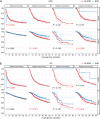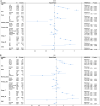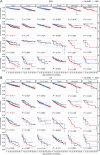Do patients with cN0 oral squamous cell carcinoma benefit from elective neck dissection? A large-scale population-based study
- PMID: 38184544
- PMCID: PMC10771637
- DOI: 10.1186/s12903-023-03632-5
Do patients with cN0 oral squamous cell carcinoma benefit from elective neck dissection? A large-scale population-based study
Abstract
Background: The neck management of clinical-nodal negative (cN0) oral squamous cell carcinoma (OSCC) remains controversial. Elective neck dissection (END) and observation are the main strategies, but it is still not clear who could benefit the most from END. The purpose of this study was to clarify the potential clinical factors that affect the therapeutic value of END and to explore the actual characteristics associated with benefit from END.
Methods: Patients with cN0 OSCC were identified in the SEER database from 2000 to 2019. 5-year Overall survival (OS) and disease-specific survival (DSS) were analyzed using the Kaplan‒Meier method, and the hazard ratios (HRs) for survival were estimated using the Cox regression model. Multiple subgroup analyses of DSS and OS among different factors, comparing END and No END, were performed.
Results: A total of 17,019 patients with cN0 OSCC were included. The basic survival analysis and Cox regression model showed that END increased the probability of 5-year DSS and OS and was an independent prognostic factor. However, among patients who underwent only primary tumor surgery, no significant differences were found between the END and No END groups in 5-year DSS (P = 0. 585) and OS (P = 0.465). Further subgroup analysis showed that primary sites and T stage, but not other factors, might influence the benefit of END. Significant differences were found for T1 (P < 0.001 for OS) and T2 (P = 0.001 for DSS and < 0.001 for OS) tongue squamous cell carcinoma (TSCC) but not for other primary tumor sites.
Conclusion: This large-scale retrospective population-based cohort study suggests that not all patients with cN0 OSCC could benefit from END. Patients with cN0 TSCC are recommended to undergo END, especially with early-stage tumors.
Keywords: Clinical-nodal negative; Disease-specific survival; Elective neck dissection; Multiple subgroup analyses; Oral squamous cell carcinoma; Overall survival; SEER database.
© 2023. The Author(s).
Conflict of interest statement
The authors declare that they have no competing interests.
Figures





Similar articles
-
Neck dissection improves the prognosis of patients with early-stage oral squamous cell carcinoma.Sci Rep. 2025 Apr 4;15(1):11640. doi: 10.1038/s41598-025-96018-2. Sci Rep. 2025. PMID: 40185843 Free PMC article.
-
Elective neck dissection improves the survival of patients with T2N0M0 oral squamous cell carcinoma: a study of the SEER database.BMC Cancer. 2021 Dec 7;21(1):1309. doi: 10.1186/s12885-021-09053-3. BMC Cancer. 2021. PMID: 34876079 Free PMC article.
-
Effectiveness of sentinel lymph node scintigraphy and intraoperative gamma probing with gold standard elective neck dissection in patients with N0 oral squamous cell cancers.Nucl Med Commun. 2019 Nov;40(11):1138-1147. doi: 10.1097/MNM.0000000000001090. Nucl Med Commun. 2019. PMID: 31568193 Clinical Trial.
-
Elective neck dissection in T1/T2 oral squamous cell carcinoma with N0 neck: essential or not? A systematic review and meta-analysis.Eur Arch Otorhinolaryngol. 2020 Jun;277(6):1741-1752. doi: 10.1007/s00405-020-05866-3. Epub 2020 Feb 25. Eur Arch Otorhinolaryngol. 2020. PMID: 32100133
-
Neck nodal recurrence and survival of clinical T1-2 N0 oral squamous cell carcinoma in comparison of elective neck dissection versus observation: A meta-analysis.Oral Surg Oral Med Oral Pathol Oral Radiol. 2020 Apr;129(4):296-310. doi: 10.1016/j.oooo.2019.10.012. Epub 2019 Nov 5. Oral Surg Oral Med Oral Pathol Oral Radiol. 2020. PMID: 32107184
Cited by
-
Neck dissection improves the prognosis of patients with early-stage oral squamous cell carcinoma.Sci Rep. 2025 Apr 4;15(1):11640. doi: 10.1038/s41598-025-96018-2. Sci Rep. 2025. PMID: 40185843 Free PMC article.
References
-
- Pfister DG, Spencer S, Adelstein D, et al. Head and Neck Cancers, Version 2.2020, NCCN Clinical Practice Guidelines in Oncology. J Natl Compr Canc Netw. 2020;18(7):873–98. - PubMed
-
- Warshavsky A, Rosen R, Nard-Carmel N, et al. Assessment of the Rate of Skip Metastasis to Neck Level IV in Patients with Clinically Node-Negative Neck Oral Cavity Squamous Cell Carcinoma: A Systematic Review and Meta-analysis. JAMA Otolaryngol Head Neck Surg. 2019;145:542–548. doi: 10.1001/jamaoto.2019.0784. - DOI - PMC - PubMed
Publication types
MeSH terms
Grants and funding
LinkOut - more resources
Full Text Sources
Medical

